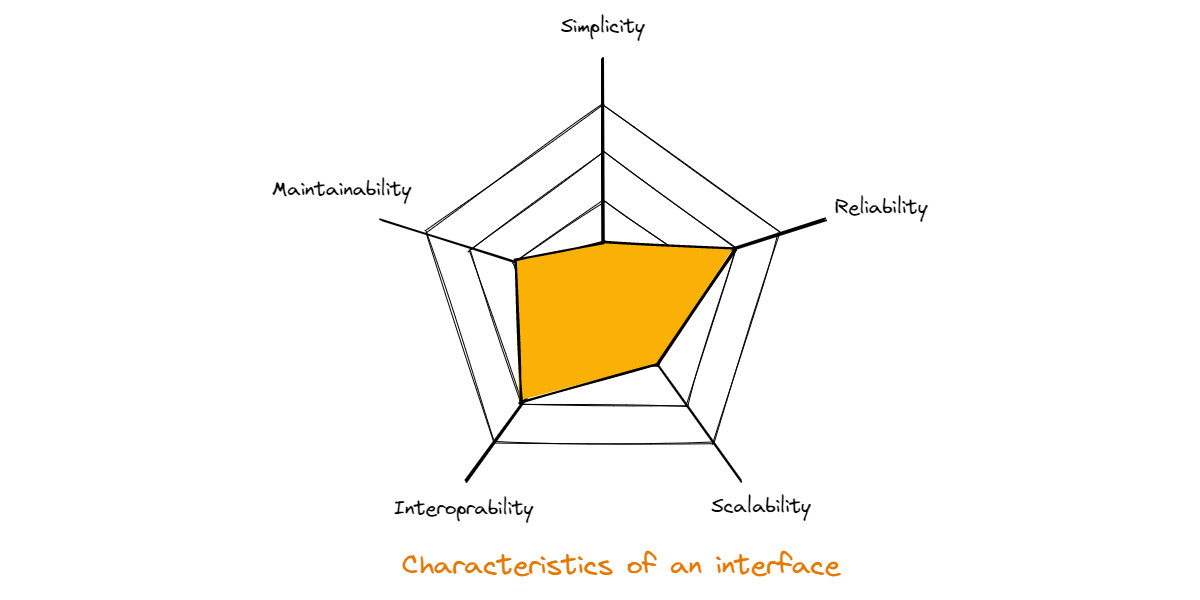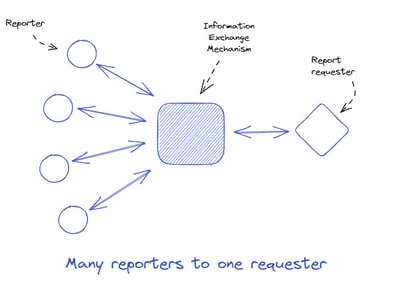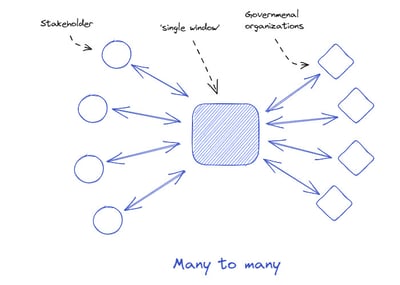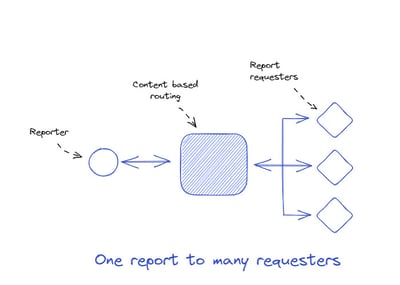Examining the Fundamental Elements of an Information Chain
In today's interconnected world, the exchange of information plays a crucial role in the effective functioning of institutions and organisations. Whether for regulatory supervision, benefit allocation, or policymaking, institutions heavily rely on the accurate and timely exchange of information, as it is essential for decision-making and business processes.
In this blog
- The Vital Links in an Information Chain: A Breakdown
- Recurring Patterns of Data Exchange in Governmental Entities and Organizations
- A chain is as strong as its weakest link
- Governance is key
- Let's continue the conversation
Read further below 👇
Once two or more parties engage in the exchange of information, an information chain is formed. In its simplest form, an information chain involves transferring information between two parties: one that requires specific information and another that possesses the necessary data or has an obligation to report it.
For this reason, having efficient and reliable information channels is crucial for organisations to function smoothly and achieve their objectives. However, as this information is often obtained from various sources, including other agencies, citizens, or external organisations, information chains can become more complex, involving multiple parties interacting in parallel or following intricate interaction patterns. By understanding the dynamics and significance of information exchange in chains, we can recognise its vital role in various sectors, including governance, public services, and policymaking. In this blog, we will delve into the concept of an information chain in its basic form involving two parties and other more intricate scenarios involving multiple entities.
The Vital Links in an Information Chain: A Breakdown
In an information chain, the chain consists of various links, each serving a specific role. These links include:
- Reporting subject, which refers to the entity being reported on. A subject can take many forms, including an organisation, a person, an object like a container, or even an activity resulting from a production process.
- Reporters who voluntarily or mandatory report on the subject. They collect the required data and create the report.
- Auxiliary services that bring additional services to the information chain; for example, auditors bring trust through validation or signing off on reports. Other examples are a (trusted) look-up registry of participants, the delegation of authorisations, and the identification of participants.
- Senders who handle the technical transfer of information and are often intermediaries or solution providers for integration. For example, bookkeepers or suppliers of (SaaS) solutions that offer integrations for information exchange.
- Data standard setters define the format and structure of the data, specifying how data should be received. Depending on the data standard, they can be optimised to be human or machine-readable. Data can be presented either in an ‘Unstructured’ way, which is unsuitable for automatic processing (e.g., Text in a document or email, PDF, unstandardised Excel/CSV) or in a ‘Structured’ way (e.g., Excel/CSV based on templates, JSON, XML and XBRL). Or, in the case of iXBRL, both.
- Interfaces, such as email, portals, REST APIs, or ebMS, facilitate the exchange of information and have characteristics like simplicity, reliability, scalability, interoperability, and maintainability. Choosing the correct interface type given the context is very important in achieving successful information exchange.

- Data exchange processes, which ensure information reliability, security, validation, conversion, and distribution. Depending on the requirements of the information exchange performed, they can ensure access control, validation, conversion, assurance, distribution, audit, and reliability.
- Receivers, like senders, handle the technical transfer of information, often as service providers or middleware components to integrate into an IT infrastructure.
- Data requesters/processors, which process the received data in their core processes, making decisions or performing analyses based on it. They may have different data needs and require transformations or optimisations for specific tasks or systems.
Other stakeholders, who, while not directly participating in the information exchange, hold a vested interest in it. These include sector associations, legislative bodies, impacted stakeholders, members of civil society, academics, and non-governmental organisations.
10 lenses to give you the insights you need into information exchange
 Information exchange is not fun, but it is necessary. Just as how we use a common language to communicate with others, companies and regulators need a standardised way to speak the same language when exchanging financial and business information. Adopting a standardised language to exchange information is essential to ensure compatibility and comprehension between all participants. Read more
Information exchange is not fun, but it is necessary. Just as how we use a common language to communicate with others, companies and regulators need a standardised way to speak the same language when exchanging financial and business information. Adopting a standardised language to exchange information is essential to ensure compatibility and comprehension between all participants. Read more
A chain is as strong as its weakest link
The role of information chains in the efficient functioning of institutions and organisations is immense, especially in governance, public services, and policymaking. They consist of several key components, including the reporting subject, auxiliary services, senders, data standards, interfaces, data exchange processes, receivers, and data requesters/processors. These elements are not simply individual links but interdependent parts of a complex system. The successful interaction of these components is the backbone of effective data exchange. In many ways, this makes the entire process more of an organisational challenge than a purely technical one.
Each link plays a pivotal role and heavily depends on the other links to function effectively. If even one link fails or does not cooperate, it can cause disruptions in the entire information exchange process, leading to potential inefficiencies or inaccuracies. The way the links interact, we call a pattern.
Recurring Patterns of Data Exchange in Governmental Entities and Organizations
In the realm of data exchange, three recurring patterns can be observed. The first pattern involves multiple reporters providing information to a single organisation. This commonly occurs when numerous parties have a reporting obligation to a central governmental entity. An example of this can be seen in the collection of annual reports by the Chamber of Commerce.
involves multiple reporters providing information to a single organisation. This commonly occurs when numerous parties have a reporting obligation to a central governmental entity. An example of this can be seen in the collection of annual reports by the Chamber of Commerce.
The second pattern entails multiple organisations exchanging information with various stakeholders through a shared service platform. The aim is to provide organisations and citizens with a consolidated interface, acting as a unified ‘window’ through which they can interact with multiple governmental agencies. An illustration of this pattern in the Netherlands is the ‘MijnOverheid Berichtenbox’.
various stakeholders through a shared service platform. The aim is to provide organisations and citizens with a consolidated interface, acting as a unified ‘window’ through which they can interact with multiple governmental agencies. An illustration of this pattern in the Netherlands is the ‘MijnOverheid Berichtenbox’.
The third pattern arises when a single reporter must provide information to multiple government agencies. In such cases, subsets of information may be distributed based on specific interests, utilising a concept known as content-based routing. For instance, information about imported goods may be disseminated to the tax office, customs authorities, and the organisation responsible for border security.In practice, you often see variations or combinations of these exchange patterns. Understanding these patterns is crucial for designing efficient and effective information exchange systems that meet the specific needs and requirements of the involved parties.
multiple government agencies. In such cases, subsets of information may be distributed based on specific interests, utilising a concept known as content-based routing. For instance, information about imported goods may be disseminated to the tax office, customs authorities, and the organisation responsible for border security.In practice, you often see variations or combinations of these exchange patterns. Understanding these patterns is crucial for designing efficient and effective information exchange systems that meet the specific needs and requirements of the involved parties.
Governance is key
In conclusion, with such intricate dynamics, the organisation and design of information chains emerge as critical determinants of the success of the entire system. In many cases, however, the responsibility and authority over information chains' governance remain ambiguous. The question of 'who is in the lead?' often arises. Some links in the chain might need clarification about their roles or lack the incentive to cooperate fully, either due to a misalignment of objectives or a perceived lack of direct benefits. Moreover, certain entities may have different priorities. Overcoming these challenges requires not only technical acumen but also robust governance and communication strategies.
Let's continue the conversation
Do you have any insights or best practices on how to deal with the complex dynamics of information exchange? We encourage you to share your thoughts and experiences on the importance of information chains and the challenges involved in managing these systems’ interdependencies. Please share them with us on LinkedIn!
And stay tuned because, in our upcoming blog post, we will delve deeper into these challenges, exploring potential solutions to enhance cooperation and streamline the information exchange process.
For those interested in delving deeper into this topic, we invite you to read our related post on 'The 10 Lenses of Information Exchange'. It dives into the different views we take when analysing and designing data exchange solutions.
Fill out the form below, and we'll contact you soon
Let's continue the conversation
Do you have any insights or best practices on how to deal with the complex dynamics of information exchange? We encourage you to share your thoughts and experiences on the importance of information chains and the challenges involved in managing these systems’ interdependencies.
For those interested in delving deeper into this topic, we invite you to read our related post on 'The 10 Lenses of Information Exchange'. It dives into our different views when analysing and designing data exchange solutions.


